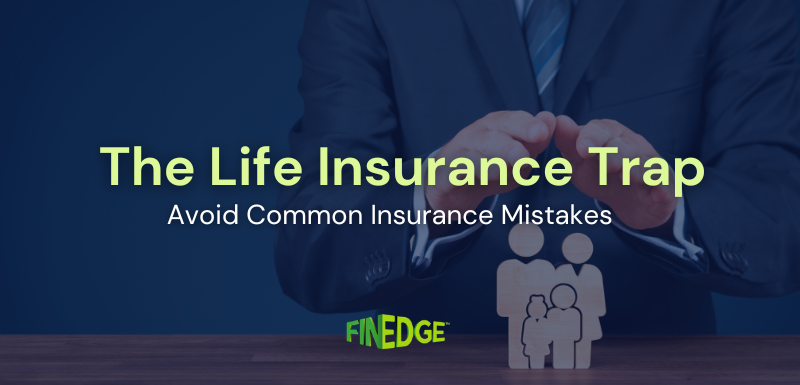Beware of the Life Insurance Trap
- Mis-selling in insurance often leaves investors underinsured.
- Learn how traditional and ULIP plans differ in structure and purpose.
- Discover five common life insurance sales traps.
Many life insurance buyers mistake savings for protection. Here’s how to spot common mis-selling traps and ensure your policy truly secures your family’s future.
Did you know that despite paying over ₹6 lakh crore in life insurance premiums every year, most Indians remain underinsured? It sounds paradoxical, but it’s true.
The reason lies in how life insurance is sold, often as a savings or investment product, not a protection tool. Instead of focusing on life cover, buyers are swayed by misleading promises of “guaranteed returns” and “tax benefits.”
In a country where life insurance is sold, not bought, mis-selling has become an unfortunate norm. Let’s decode how these traps work, why they persist, and what you can do to protect yourself from them.
Why Most Life Insurance Buyers End Up Disappointed
Not all life insurance plans are built alike. Some offer fixed benefits, others are market-linked, and many don’t offer any maturity value at all. But the real concern lies in how they’re pitched.
Agents often highlight the “investment” aspect of policies because plans with smaller premiums and pure protection, such as term plans, don’t earn them large commissions.
The result? Investors end up with multiple low-cover, low-return policies that barely protect their families or grow their wealth.
After ULIP commissions were cut in 2009, focus shifted to traditional endowment plans. The problem? These plans typically generate 4–5% annual returns, far lower than inflation or mutual fund alternatives.
Five Common Life Insurance Sales Traps
1. “Guaranteed returns even in volatile markets!”
No life insurance plan truly guarantees returns. Even “traditional” plans offer bonuses linked to insurer performance, not fixed yields. ULIPs, meanwhile, fluctuate with markets.
2. “Better than mutual funds, and tax-free!”
While returns from some policies may be tax-free, their overall yield rarely crosses 5–6% over the long term. When adjusted for inflation and charges, mutual funds still outperform.
3. “Perfect for your child’s education goals!”
Traditional plans promising future cash flows ignore inflation. Education costs rise 7–10% annually, meaning a plan yielding 5% won’t keep pace.
4. “New ULIP, low NAV, high potential!”
A low Net Asset Value (NAV) doesn’t make a ULIP cheaper or better. Performance depends on portfolio quality, not entry NAV.
5. “You get free fund switches every year!”
Frequent fund switches in ULIPs often encourage short-term timing, a habit that erodes returns rather than enhancing them.
Three Misleading Insurance Communications
Some insurance marketing messages use selective details to sound irresistible. Here are examples of misleading promotions:
-
“Invest ₹1.6 lakh/year for 12 years, get ₹1 crore tax-free!”
Reality: The maturity benefit often comes after 30+ years, translating to roughly 5–6% annualised returns, not 23%. -
“Get ₹30,000 monthly pension by investing ₹3,000/month!”
Reality: Without context on tenure or returns, this claim is incomplete. True pension plans require decades of consistent investing. -
“₹1 crore cover for just ₹4,265 per year!”
Reality: The quoted rate usually applies to a 24-year-old healthy non-smoker. Most real-life premiums are two to three times higher.
How to Avoid Life Insurance Traps
-
Identify your purpose: Ask yourself if you want protection or investment growth. Life insurance should primarily offer risk coverage, not act as your core investment tool.
-
Calculate your life cover need: Use the Human Life Value (HLV) or Needs-Based approach, factoring in income replacement, debts, and dependents’ needs.
-
Review your existing policies: Create a simple spreadsheet with all your insurance details, premiums, tenure, and coverage. It helps you see if you’re underinsured or overpaying.
-
Separate insurance and investment: Combine a pure term plan with mutual fund SIPs or goal-based portfolios for better long-term balance.
-
Seek conflict-free guidance: Always consult qualified professionals who are not commission-driven before buying or renewing a policy.
FAQs
Your Investing Experts
Continue Reading
The Impact of Inflation on Your Retirement Plan
Inflation doesn’t feel alarming month to month, but over 25 years it can completely reshape your retirement needs. Planning with inflation in mind ensures your future lifestyle remains as comfortable as it is today.
Financial Planning Before and After Retirement India: A Complete Guide to Building & Managing Your Retirement Life
Planning for retirement is not just about saving, it’s about understanding how your needs evolve. Financial planning before and after retirement India requires two different skill sets: building your corpus before retirement and managing it wisely afterward so it lasts 25–30 years.
Beware of the Life Insurance Trap
Many life insurance buyers mistake savings for protection. Here’s how to spot common mis-selling traps and ensure your policy truly secures your family’s future.

.png)

